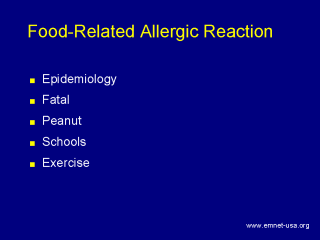| front |1 |2 |3 |4 |5 |6 |7 |8 |9 |10 |11 |12 |13 |14 |15 |16 |17 |18 |19 |20 |21 |22 |23 |24 |25 |26 |27 |28 |29 |30 |31 |32 |33 |34 |35 |36 |37 |38 |39 |40 |41 |42 |43 |44 |45 |review |
 |
Food-induced anaphylaxis
has some specific issues critical to appropriate management and prevention.
The incidence of food allergy and anaphylaxis has been increasing in the
past 20 years. More children are demonstrating peanut allergy, possibly
related to early exposure to peanut allergens in breast milk as well as many
pro-allergic environmental influences. More adults are reporting allergic
reactions to foods including seafood as well as ingredients often related to
more adventurous eating habits and more exposure to a wide range of
foreign/regional ingredients, herbs, and spices.
There have been more reports and investigations of fatal food anaphylaxis, with one most noticeable factor being the delayed use of epinephrine often due to delayed recognition of the reaction and insidious progression of symptoms to a severe and refractory level. Peanut allergy has become the "poster child" of food allergy with increasing recognition of the occurrence of life-threatening and fatal reactions which should be preventable in children with known sensitivities. Reactions to peanut can be dangerous from minute quantities, even in children who previously had mild reactions. Anaphylaxis in the schools has been the subject of position statements by the AAAAI as well as the American Academy of Pediatrics. Education has increased awareness by physicians, school nurses, educators and the general public. However, a detailed plan of action should be prepared for each child by the pediatrician and allergist. It is critical that epinephrine be readily available at all times. Exercise can cause anaphylaxis as well as asthma or urticaria, and has been recognized as a co-factor in many cases of food-related anaphylaxis. There may be a need to adjust the nature or timing of physical activity in patients with food allergy and anaphylaxis. |